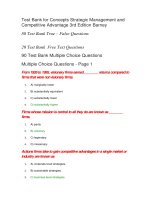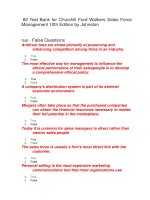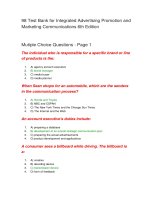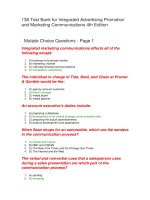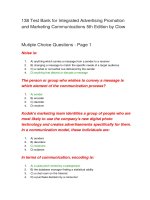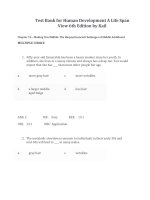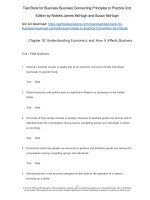Test bank for engendering psychology women and gender revisited 2nd edition by denmark
Bạn đang xem bản rút gọn của tài liệu. Xem và tải ngay bản đầy đủ của tài liệu tại đây (127.9 KB, 25 trang )
Instructor’s Manual and Test Bank
for
Denmark, Rabinowitz, and Sechzer
Engendering Psychology
Women and Gender Revisited
Second Edition
prepared by
Maram Hallak
Borough of Manhattan Community College
City University of New York
Boston New York San Francisco
Mexico City Montreal Toronto London Madrid Munich
Hong Kong Singapore Tokyo Cape Town Sydney
Paris
From />
Copyright © 2005 Pearson Education, Inc.
All rights reserved. The contents, or parts thereof, may be reproduced with Engendering
Psychology: Women and Gender Revisited, Second Edition, by Florence L. Denmark,
Vita Carulli Rabinowitz, and Jeri A. Sechzer, provided such reproductions bear copyright
notice, but may not be reproduced in any form for any other purpose without written
permission from the copyright owner.
To obtain permission(s) to use the material from this work, please submit a written
request to Allyn and Bacon, Permissions Department, 75 Arlington Street, Boston, MA
02116, or fax your request to 617-848-7320.
ISBN 0-205-43926-8
Printed in the United States of America
10 9 8 7 6 5 4 3 2 1
09 08 07 06 05 04
From />
Table of Contents
Page
Introduction
1
Chapter 1.
Exploring Sex and Gender
6
Chapter 2.
The Implication of Mythology and Religion on
Women and Gender
23
Chapter 3.
Culture, Ethnicity, Race and Class
39
Chapter 4.
Biology of Sex and Gender
52
Chapter 5.
Growing Up
63
Chapter 6.
Ability and Achievement
84
Chapter 7.
The World of Work
99
Chapter 8.
Sexuality
114
Chapter 9.
Intimate Relationships: Women as Lovers,
Spouses, Family and Friends
131
Chapter 10. Parenting and Reproductive Issues
147
Chapter 11.
Growing Older
157
Chapter 12.
Gender, Violence and Exploitation
167
Chapter 13.
Issues in Mental Health
176
Chapter 14.
A Gendered View of Physical Health
184
From />
INTRODUCTION
Courses in the psychology of women and gender are not ordinary courses. Those of us
fortunate enough to teach these courses know that they are uncommonly engaging for our
students. However, they are also unusually demanding, for instructors and students alike.
By their very nature, courses on the psychology of women and gender are intellectually
and emotionally challenging. They require people to reexamine their most personal
experiences and rethink their deepest assumptions about women, men, sex and gender, as
well as reconsider the interrelationships between biology and culture, human
development, ability and achievement, intimate relationships, and mental and physical
health. This inherently interdisciplinary field requires teachers and students to integrate
material across scholarly disciplines ranging from the natural sciences to the humanities.
The second edition of Engendering Psychology: Women and Gender Revisited by
Florence L. Denmark, Vita C. Rabinowitz, and Jeri Sechzer provides an excellent
foundation to meet all these challenges. This text is extraordinarily rich in scholarship
and analysis. Yet, it is not enough to simply read about the psychology of women and
gender. Courses like this require special support for instructors who seek to enhance their
students’ appreciation of theories, concepts, and research through class discussions,
group activities, exercises, and fieldwork, as well as through examinations.
This instructor’s manual is specifically designed to serve as a guide to the second edition
of Engendering Psychology: Women and Gender Revisited. The manual begins with a
few brief thoughts on general considerations in teaching the psychology of women and
gender, and then proceeds to a chapter-by-chapter guide. There are 14 chapters in the
Instructor’s Manual, each of which corresponds to the same numbered chapter in the
Engendering Psychology textbook. You’ll note that each chapter in this manual includes
the following:
•
•
•
•
Chapter Highlights/Summary
This section underscores the major topics covered in each chapter and provides
definitions for key terms.
Discussion Topics and Classroom Activities
These are provided with the intent of helping students to develop a deeper
understanding of the topics and issues discussed in the textbook.
Chapter Tests
For each chapter, there are 20 multiple-choice questions and 5 essay questions.
The test items generally focus on three main objectives: explaining concepts and
definitions, relating and critically analyzing concepts, and applying concepts to
real world situations.
References and Suggested Readings
1
From />
At the end of every chapter, I list a number of web links, reading resources, and
videos that can be helpful in finding additional material to enrich lectures and
classroom discussions. These can also be provided to students as additional
vehicles to assist them in completing class assignments.
2
From />
General Considerations in Teaching the Psychology of Women
Course Guidelines:
When teaching a course in which personal, sensitive, and controversial issues are
likely to arise, it is useful to introduce a set of guidelines aimed at increasing students’
awareness and comfort level. For this purpose, make a list of suggestions that are
important for creating and maintaining a constructive classroom environment.
Discussing the relevance of each item can also serve as a useful ice-breaker at the
beginning of a course. I am fortunate to have the approval of Lisa Bowleg, associate
professor at the University of Rhode Island, to use her list of the following classroom
guidelines.
1. Respect for diverse opinions: In comparison to other types of classes, many of the
topics that we will discuss in this class are sensitive areas in which people may have
preexisting opinions. Inevitably, there will be issues on which we disagree. While
disagreement is fine, disrespect is not. I encourage you to voice your opinions freely,
including opposing points of view, and to allow your classmates the opportunity to
voice their perspectives without interruption or fear of personal attack. Also
remember that sometimes we simply must agree to disagree.
2.
Disclosure of personal information: I encourage you to disclose personal
information to the extent that it is relevant to the topics that we cover in this course.
However, sharing personal information is not required and you will not be penalized
for not doing so. Avoid disclosing deep secrets or more information than you feel
comfortable disclosing. You, and only you, reserve the right to disclose personal
information in class. Moreover, remember that while personal experience is certainly
a valid part of learning, your experience has a sample size of one. Even though many
people may share your experience, your experience is not necessarily the definitive
one, and therefore cannot be generalized to all people.
3. Confidentiality: Please guard the privacy of your classmates by not sharing personal
information disclosed in class with others outside of class. Similarly, you should
protect the privacy of those outside of the class (e.g., friends, roommates). If you feel
you must share information about someone else that is relevant to a class topic, try to
make your description of the person and/or event as anonymous as possible. As for
your papers, I will be the sole reader and will keep all of the information provided in
your papers confidential.
4. Critical thinking & analysis: Avoid the anti-intellectualism that results from illinformed perspectives and unexamined assumptions. Ask questions such as: What is
fact? What is opinion? What is propaganda? Phrases such as, "Well, it's just always
3
From />
been that way" or " It's just impossible to change people" are examples of shallow
thinking that do nothing to advance intellectual growth.
5. Beliefs & Values: There are no rewards or penalties for anyone’s beliefs or values.
However, I encourage you to challenge yourselves to critically investigate your
values and beliefs. Think about where you learned them. When? From whom? Are
these your own beliefs or beliefs passed down by others? Be open-minded and willing
to learn from others.
6. Work through your discomfort: Due to the nature of this course, discomfort is
virtually guaranteed for several of the topics that we will discuss. While these ground
rules are designed to foster a safe learning atmosphere, it is important that you do not
confuse safety with comfort. Indeed, discomfort is an important indicator of growth
(Adams & Marchesani, 1997).
7. Recognize and value different experiences: Never demean, devalue or in any way
denigrate people for their experiences. Your not having had a specific experience
does not negate or invalidate someone else's experience (For example, you may not
have ever witnessed a racist act, but that does not mean that racism does not exist.)
8. Avoid the homogeneity bias: Do not single any member(s) of the class out as the
representative(s) or spokespersons for any particular group. Examples of this would
be asking a transgendered person to answer the question "How do transgendered
people feel about…?" or asking a Korean student to tell what "Korean students think
about…".
9. Languages & stereotypes: The Whorfian hypothesis tells us that language shapes
and constrains thought. To this end, I encourage you to monitor the language that you
use when discussing topics this semester. If you suspect that a word or term might be
offensive, then err on the side of caution and choose another word. Also be aware of
language that: (1) stereotypes entire groups of people (e.g., "All Latino men do …;
All heterosexual women want …"; )(2) devalues people (e.g., calling adult women
"girls"); (3) is not gender-neutral (e.g., avoid the use of the generic "he" as in the
sentence, "If a person wants to succeed in life, he must…"; and (4) robs individuals of
their integrity as human beings (e.g., notice the difference between "disabled people"
and “people with disabilities."
10. Other? ______________________________________________________________
________________________________________________________________________
________________________________________________________________________
________________________________________________________________________
________________________________________________________________________
4
From />
Ice breaker exercises
In addition to discussing guidelines at the beginning of a course, it can be valuable to
engage the class in other ice breaker activities that encourage class participation and
foster group cohesiveness. The following activities can be particularly engaging when
students pair off, discuss the subject matter with their partner, and then present their
partners’ information to the class. Partnering up students can also be done with simple
introductions including name, major, interest in the psychology of women, etc.
“My _______ named me ____________ because”
Until I was a participant in a similar exercise when I was a student at the
University of Massachusetts, I had no idea that name origin could be so
meaningful. Ask students to introduce themselves to the person sitting
next to them and describe the special circumstances under which they
were given their names. I have heard students share examples of being
named after the nurse in the delivery room, a grandparent, a historic
figure, and a movie star. This exercise can produce a warm first class
interaction, and will help students and teachers get to know each other, as
well as remember each other’s names!
“Whom do you admire?” exercise
This is a good exercise that helps us to explore our values, which will play
an important role in this class. Ask students to write about a person who
has had a positive impact on their lives, such as a family member, fictional
character, historic figure, movie star, etc. Students should write down
three qualities that make this person admirable. As students present the
traits they selected with the class, discuss the implications of these
qualities for our beliefs and values about what comprises an ideal person
or an ideal life.
5
From />
CHAPTER 1
EXPLORING SEX AND GENDER
CHAPTER HIGHLIGHTS:
This chapter lays out the basic framework for the distinctions between sex and
gender. Sex is defined as “the biological differences in the genetic composition and
reproductive system,” and is ascribed to both animals and humans. Gender, on the other
hand, is limited to humans. Gender is a socially constructed concept that refers to how
differences between boys and girls and men and women are created, maintained and
explained by society.
Beliefs about gender are analyzed through several approaches. The cultural
approach states that societal rewards and punishments reinforce and perpetuate gender
stereotypes. The structural approach focuses on the ongoing structural and social role
requirements that channel each person’s gendered experience. The cognitive perspective
explains beliefs about gender through stereotypes, or the way people condense
information into manageable categories based on some similarity among group members.
This chapter provides a discussion of the effects of sex discrimination on various aspects
of our society, and our personal and professional lives. Three forms of sexism are
mentioned: blatant, subtle, and covert.
Feminist ideologies and perspectives are also presented in this chapter. A feminist
is broadly defined as a person (woman or man) who promotes equality for all, seeks
social justice, and values human rights nationally and internationally. There is not one
type of feminist; socialist, radical, cultural, and liberal feminists all hold different
perspectives on feminism that inform research and generate theory.
The last part of the chapter is devoted to a discussion of traditional research
methods and the ways in which they can be limited and/or biased. Feminists have
critiqued traditional research strategies and provided a number of guidelines for genderfair research. These solutions hinge on accepting that science can never be completely
value neutral. However, research can be more gender-fair when researchers are mindful
of the way they formulate research questions, conduct literature reviews, choose research
participants, implement research designs, operationalize variables, and analyze and
interpret their results.
DISCUSSION TOPICS AND CLASSROOM ACTIVITIES:
Why the psychology of women?
This exercise can serve as an opening discussion for the course. Engage the class
in a conversation about the following questions: How has psychology as a discipline
represented females? To what extent is general psychology the psychology of men?
6
From />
Ideally, what would a psychology of women look like? Ultimately, what would the
psychology of men, in which men were studied as men rather than as exemplars of
humanity, look like? This book hopes to go beyond a psychology of women to explore
the psychology of gender and, by extension, all people.
This discussion can lead to an examination of the history of the sub-discipline, the
reasons for the birth of the psychology of women, and evidence of its progress in our
college curricula. It can help students to ponder the valuable contributions of this
discipline to our scholarly wealth, social justice, and human rights.
Examples of feminist contributions
A discussion of the scholarship and activism of some historical and contemporary
women/feminist leaders provides a good foundation in which to consider and appreciate
the value of such contributions from a social/cultural context. Texts and websites are full
of information on such role models and their considerable accomplishments. I find this
discussion to be essential, since women’s work is at times overshadowed and often
underestimated.
Use the list of names in Handout 1.1, or develop a list of your favorite feminist
leaders, activists, scientists, researchers, scholars and teachers who made real changes in
the world. Ask students to conduct a search and bring their findings back to class. In
addition to acknowledging those who lead the way, students benefit greatly from the
wonderful examples set by these women and men.
Stereotypes, prejudice and discrimination
After discussing the difference between sex and gender, ask students to come up
with examples of what constitutes gender. This really helps the students illuminate the
stereotypical elements comprising gender. Make a list of their examples and show that
not all men or all women share these traits or engage in these behaviors, except for the
most basic biological characteristics. In fact, in our society especially, we are moving
away from stereotypic descriptions that restrict us as women and men.
Discuss the usefulness (if any) or uselessness of assumptions about women and
men, analyze how they are formed and explore the reasons for their persistence, even
when they appear to be simplistic, misleading and/or harmful. This could lead to a
discussion of the effects of stereotypes on prejudice and discrimination. I like to end with
some possible plans of action to transcend or limit stereotypes. Some ideas students have
generated include the use of language free of stereotypes, attention to continuously
questioning stereotype dominance, as well as understanding stereotypes as tools of power
and control. Handouts 1.2 through 1.5 are useful in helping students understand gender,
stereotypes, prejudice, and discrimination.
The label of “ feminist”
Pondering the status and connotations of the label of “feminist” can launch great
discussions. You can open a class by asking students to raise their hand if they consider
themselves a feminist. Usually, only a few admit that they are, but the rest tend to follow
7
From />
as the class discussion progresses. An introduction to the various ideologies of the four
main schools of feminism--social, radical, cultural, and liberal--is valuable in helping
students learn that there is not one type of feminism.
Feminism is almost always misunderstood and frequently accused of platforms
for which it does not stand. For example, feminists are accused of bashing men and
wanting to overcome men. Some of my favorite reactions occurred when former students
asked if this feminist teacher shaved her underarms or wore a bra. A student once
reported that her boyfriend warned her about the biases that will be introduced in the
course due to teacher’s philosophy and practices of feminism. To clarify some
misconceptions about feminists, follow the exercise on Handout 1.6.
Feminist critiques of traditional research
There is a large body of evidence showing bias against women and minorities in
research. In most classes, science is presented as a dispassionate activity in which the
scientist is not sentimental, irrational, emotional or imprecise. However, there are many
seemingly hidden biases that can negatively impact research. Some examples of this
include bias in formulating the research question (a researcher assumed that men are
better than women on spatial abilities), and bias in the review of literature (the researcher
ignored the areas of similarities and stressed only those studies that showed differences).
There are many other types of bias. Ask students to find a study conducted in the past 50
years with evidence of bias. This can be discussed in class. An alternative is to make up
a biased research methodology and ask students to locate the problematic areas. A
sample vignette is provided in Handout 1.7.
Feminist research methods
How do feminist researchers conduct research? This is an important discussion,
which can generate a deeper understanding of the significant progress made by the
contributions of both men and women feminist researchers.
Here are some of the points that I usually highlight:
• Feminist researchers sometimes study women’s issues as standalone topics and do not study women only in comparison to men.
This is different from traditional research methods that induced us
to think of men as the norm and woman as the deviation from the
norm.
• Feminist researchers promote the study of girls and women by
treating gender as a medium or context in which experiences
flourish. This is opposed to the traditional methods that treated
gender as an independent variable (although it cannot be
manipulated) and permitted causal statements to be made.
• Feminist researchers emphasize critical thinking and questioning
assumptions, and consider alternate explanations for gender
differences.
• Feminist researchers may employ qualitative methods that pay
8
From />
•
•
•
•
•
more attention to understanding women as well as special
populations. Qualitative methods are increasingly being used -and respected -- as a way of understanding particular topics from
the participants’ worldviews.
Feminist researchers understand experience as essentially
subjective, and understand that it cannot always be objectified.
Feminist researchers respect the social context in which
experiences occur and acknowledge problems with experimental
methods that ignore context. They view the psychological
experience in relation to social, political and economic contexts.
Feminist researchers acknowledge their own values and biases and
attempt to take these into account in every step of the research
process. They do not claim objectivity or even believe that true
objectivity is achievable, although they continue to seek fair and
just methods that can illuminate truths.
Feminist researchers acknowledge research as interactive and
participatory, placing emphasis on dialogue and collaboration, not
control and power.
Feminist researchers want their research to contribute not only to a
growing body of knowledge, but to improving conditions for
oppressed people, including women.
9
From />
Handout 1.1
These are the names of leaders, activists, scientists, researchers, scholars and teachers
who have made their mark in feminist thought. Please research at least one of them, jot
down some highlights about their accomplishments and how they lived their lives, and
bring the information to class.
Mary Whiton Calkins
Peter Glick
Dorothea Dix
Susan Fiske
Frieda Fromm-Reichmann
Mary Ainsworth
Karen Horney
Hope Landrine
Melanie Klein
Paula J. Caplan
Christine Ladd-Franklin
Laura S. Brown
Maria Montessori
Celia Kitzinger
Margaret Floy Washburn
Anne Anastasi
Florence Denmark
Betty Friedan
Bonnie Ruth Strickland
Dorothy Heights
Martha Bernal
Laura S. Brown
Leona Tyler
Loretta Bender
Janet Taylor Spence
Margaret Sanger
Dorothy Cantor
Michelle Fine
Norine Johnson
Marie Curie
Carolyn Wood Sherif
Marnie Phipps Clarke
Jessica Henderson Daniel
Mary Gergen
Jean Lau Chin
Barbara Reskin
Lillian Comas-Diaz
Rosalind C. Barnett
Beverly Greene
Anna Freud
Anne Fausto-Sterling
Suzan B. Anthony
Sandra Lipsitz Bem
Carol Gilligan
Nancy Chodorow
Linda Garnets
Janet Shibley Hyde
Gloria Steinem
Alice Eagly
Virginia Valian
Kay Deaux
Deborah Tolman
10
From />
Handout 1.2
Sometimes, students assume that only negative stereotypes are harmful. The objective of
the following activity is to show that positive stereotypes about widely recognized social
groups can also be limiting. As a class, generate a list of “positive” stereotypical traits
such as “nice”, “quiet”, “conscientious”, etc. Write each trait on a label, and place the
label on each student’s forehead so that the student is unable to read their label. Instruct
the students to interact with each other, discussing any issues they like. As they do this,
they should relate to each other based on the labels each person is wearing. The student
is not to ask what her or his label is. After about 15 minutes of interactions, the
experience is processed and students are asked to guess her/his label. This handout offers
questions for students to work through after the experience. When all the students
complete the questions, ask for volunteers to share some of their answers.
Instructions:
Take a few minutes to process the thoughts that went through your mind and the feelings
that you experienced as a result of this activity. Then, work through the following
questions:
1. Were you able to guess your label? What was it?
2. Was it difficult to guess?
3. How did you get your clues?
4. Did the label act as a barrier to the conversation in any way?
5.How did it make you feel to be judged by others who had preconceived, possibly
inaccurate, ideas of who you are?
11
From />
Handout 1.3
By a very early age, our gendered life has begun to take shape and we often feel pressure
to satisfy the social requirements of what it means to be female or male in our society.
An exercise that illustrates the power and rigidity of those labels is to have students ask
four participants to provide descriptions of women and men. This handout helps the
student collect the information and think about its implications. It is important to ask
students to select females and males that vary along the dimensions of age, ethnicity,
socioeconomic status, and sexual orientation to interview. Think about how the
characteristics of the interviewee affect their descriptions.
Instructions:
Questions for the participant:
Participant # ________
Sex:_______________
Age:___________________
Education:__________
Ethnicity:______________
Religion:___________
Marital status:___________
1. Use your own words to describe what comes to your mind when you think of a
typical woman.
2. Use your own words to describe what comes to your mind when you think of a
typical man.
3. Use your own words to describe what comes to your mind when you think of a
typical girl
.
4. Use your own words to describe what comes to your mind when you think of a
typical boy.
3. Do you think these descriptions are universal?
4. Do you know where these descriptions came from?
5
What are feminine qualities?
12
From />
6. What are masculine qualities?
7. Can a woman have both masculine and feminine qualities?
8. Can a man have both masculine and feminine qualities?
Questions for the student:
1. Do you know a man or a woman that the data you collected fail to describe?
2. If so, why do you think those faulty descriptions persist?
3. How do you think that gender roles in your society differ from those in other
societies, such as Eastern societies or developing nations? Are they more or less
defined?
13
From />
Handout 1.4
I learned one of my favorite activities from Professor Kathryn Quina at the University of
Rhode Island when I co-taught a class with her. It is called “The Female Experience” and
I am using it here with her permission. In this exercise, the student is asked to read a
Harlequin romance novel and briefly answer a set of questions provided on Handout 1.4.
This becomes a fun learning experience as students share their answers.
Read a Harlequin romance novel and briefly answer the following questions:
1. Give a brief summary of your novel. Include how the heroines and heroes were
portrayed.
2. Did the descriptions adhere to what society defines as the utmost man or the ideal
woman?
3. Imagine reading those novels through the eyes of a young teenager. What type of
message do you think you would get?
4. What are the implications for the development of gender identity?
14
From />
Handout 1.5
An exercise that demonstrates the strength of societal gender role pressures is to
ask students to violate a gender norm and report reactions to the class. Questions on
Handout 1.5 can help establish a structured discussion as well as provide guidance to
what the students need to observe and report. Students should focus on their own and
others’ reactions. Here are some examples:
•
•
•
Kai, a white male student, came to class with red nail polish on one
hand. He reported that the only other person on the train, a white
male, did everything possible to look away.
Hao, a Chinese female student broke a gender and cultural norm
when at a typical Chinese gathering, she introduced herself first
and then her spouse as her husband (the norm is to introduce the
man first and then the woman as his wife).
Elizabeth, a white female student, invited her boyfriend to dinner,
placed his order, and paid the bill.
1. List as many gender role norms you can think of. (Examples include wearing make
up, carrying boxes, opening the door, giving away your seat, giving flowers or stuffed
animals, cuddling a child, paying for dinner, etc.)
2. Choose to violate one of those norms, observe and report your findings
3. What were the responses you received and the reactions you observed?
4. Did you get resistance from others aimed at “normalizing” you?
5. Did you observe any influence of those norms on your behavior?
6. What might be the consequences of challenging the norms?
15
From />
Handout 1.6
Tell four people (other than your feminist friends) that you are taking “The Female
Experience” course taught by a Feminist professor. Then jot down their responses and
bring them to class for discussion.
Participant # 1
Sex:_______________
Age:___________________
Education:__________
Ethnicity:______________
Religion:___________
Marital status:___________
Occupation: ________
1. Did people react to the label “feminist”? If so, how?
2. Did people react to the label “feminist” in a positive way?
3. Did people react to the label “feminist” in a negative way?
4.Did anyone ask you to clarify their understanding of the definition of “feminist?”
5. What are other responses you received?
6. Jot down any additional comments.
16
From />
Handout 1.7
The following vignette is an example of a research project. Your task is to provide a
critical analysis and identify flaws cited by feminist researchers in the various stages of
the scientific investigation, including how the research question is stated, the bias in
sampling, and in the interpretation of results.
Dr. Adam Forefather is a famous psychoanalyst who wanted to investigate the
reasons why men perform better than women on tasks of spatial ability. He reviews
the literature and finds out that there are many studies that discuss those differences.
He recruits a sample of 100 participants, 50 men and 50 women. The procedure
consists of showing each participant a map of a small neighborhood for five minutes,
after which time the participant is asked to draw a map showing the way to specific
locations. His statistical analyses show no significant differences, so he abandons the
study since it doesn’t support his hypothesis.
17
From />
Chapter test questions:
Multiple choice questions
1. The Psychology of Women is considered interdisciplinary because:
A) Professors that teach the psychology of women come from different
subfields of psychology
B) It is informed by research conducted in such fields as biology, sociology,
anthropology, history, media studies, economics, education and linguistics
C) It insists on a complex interconnected science of psychology
D) It receives great attention from human rights committees and the feminist
movement
Answer B
2. Chapter 1 implies that
A) psychology can not be considered a complete science if it ignores
women’s and girl’s issues
B) sex refers to both biological and social differences
C) gender is determined purely by biology
D) estrogen and progesterone are uniquely female hormones, while androgens
are hormones that belong exclusively to males
Answer A
3. After a lecture in the psychology of women, a friend comes up with a new
explanation of why she was once refused employment. She is probably referring
to:
A) Racism
B) Sexism
C) ethnocentrism
D) feminism
Answer B
4. An example of sex is:
A) Mother
B) Teacher
C) Female
D) woman
Answer C
5. A feminist is a woman or man who:
A) discounts the contributions of men
B) overemphasizes the contributions of women
C) strives for justice and equal opportunities for all men and women
D) wants less power
Answer C
18
From />
6. The cultural approach view explains the origin of gender stereotypes from
A) The perspective that children are socialized to act in accordance with their
society’s conventions
B) the position that ongoing structural and social role requirements shape our
experience in society
C) the cultural injustices that surrounded women
D) religious and spiritual ideologies
Answer A
7. Stereotypes can be
A) Positive
B) Inaccurate
C) negative
D) all of the above
Answer D
8. Blatant sexism is different than subtle sexism in that blatant sexism
A) Is intentional, hidden, and frequently hostile
B) Is less apparent than covert sexism
C) occurs when women are treated in a transparently harmful and unequal
way
D) is less visible to others as well as to ourselves
Answer C
9. Alia states: “the marriage institution is created to enslave women.” You can
safely conclude that Alia is a
A) radical feminist
B) social feminist
C) liberal feminist
D) cultural feminist
Answer A
10. Omar argues that women should be given similar opportunities as men in the
work place. Omar is probably
A) radical feminist
B) social feminist
C) liberal feminist
D) cultural feminist
Answer C
11. Which statement describes the views of a cultural feminist:
A) women can create peace and harmony in our society due to their less
aggressive nature
B) men and women should have equal rights and opportunities
19
From />
C) major changes are needed to stop the oppression of women
D) psychology of women classes must be more effective in producing social
change
Answer A
12. If a researcher conducts a study looking for differences between women and
men’s abilities, chances are she will find those differences. This is an example of
A) experimenter bias
B) bias theoretical model
C) biased in interpretation
D) bias in sampling
Answer A
13. A psychoanalyst is investigating “penis envy” in women. This is an example of:
A) experimenter bias
B) a biased theoretical model
C) bias in interpretation
D) bias in sampling
Answer B
14. Continuing to focus on differences between males and females may serve to
A) keep women down
B) keep men down
C) understand women’s issues in a new light
D) none of the above
Answer A
15. Feminist research encourages
A) exploring various research methods including qualitative methods
B) questioning the biases contained in the literature reviews
C) questioning the biases in sampling
D) all of the above
Answer D
16. Which theory argues that “psychological traits, like physical ones, are selected
through an evolutionary process because they are adaptive?”
A) social constructionism
B) sociobiology
C) traditional feminism
D) structured fundamentalism
Answer B
17. Which view claims that behavior is not merely biological, rather is influenced by
the particular situation, the environment, history, political conditions and society as
a whole?
20
From />
A) social constructionism
B) sociobiology
C) traditional feminism
D) structured fundamentalism
Answer A
18. “We can only understand behavior in light of the social context in which the
behavior takes place.” This statement best explains the beliefs of:
A) social constructionism
B) sociobiology
C) traditional feminism
D) structured fundamentalism
Answer A
19. A research study that questions the reasons a battered woman stays with her
husband
A) sheds very important light on the behavior of battered women
B) helps guide women to effectively seek help
C) implies that the problem is really with the woman since she chooses to stay
in that relationship
D) helps the abusers understand their victims
Answer C
20. Feminist theorists value
A) considering your own biases when doing research
B) critically questioning traditional research methods and findings
C) trying to understand the issue from the participants’ point of view
D) all of the above
Answer D
Essay test questions
1. Differentiate between the sociobiological and the social constructionist views of
gender.
2. Explain and give examples of the cultural approach and the structural approach
and how they conceptualize the process of socialization of men and women.
3. Discuss the four schools of feminism mentioned in the text (socialist, radical,
cultural, and liberal) and give examples of each.
4. Describe three areas where feminist researchers criticize traditional research.
What are the problems with research that focuses on gender differences?
5. What is feminism? How has feminism positively affected research in
psychology?
21
From />
References and suggested readings
Bem, S. (1993). The lenses of gender. New Haven, CT: Yale University Press.
Bronstein, P., & Quina, K. (2003). Teaching a psychology of people: Resources for
gender and sociocultural awareness (2nd ed.). Washington, DC: American
Psychological Association.
Caplan, P.J., & Caplan, J. B. (1999). Thinking critically about research on sex and gender
(2nd ed.). New York: Longman.
Fine, M., Torre, M., Boudin, K., Bowen, I., Clark, J., Hylton, D., Martinez, M., Missy,
Roberts, R., Rivera, M., Smart, P., and Upegui, D. (2003). Participatory research:
Behind bars and under surveillance. In Paul Camic and Jean Rhodes (ed)
Qualitative methods. Washington, DC: American Psychological Association.
Fine, M., & Vanderslice, V. (1994). Qualitative activist research: Reflections on methods
and politics. Pp. 199-207. In Bryant, F. B., et al. (Ed.), Methodological issues in
applied social psychology. NY: Plenum.
Kinsler, K., & Zalk, S.R. (1996). Teaching is a political act: Contextualizing gender and
ethnic voices. In K.F. Wyche & F. Crosby (Eds.), Women's ethnicities:
Journeys through psychology (pp. 27-48). Boulder, CO: Westview.
Shields, S. (1975). Functionalism, Darwinism, and the psychology of women: A study in
social myth. American Psychologist, 30, 739-754.
West, C., & Fenstermaker, S. (1995). Doing difference. Gender & Society.9, 8-37
Yoder, J.D., & Kahn, A.S. (1993). Working toward an inclusive psychology of women.
American Psychologist. 48. 846-850.
Useful web links
American Psychological association
www.apa.org
American Psychological Society
www.psychologicalscience.org
Psychology of Women
/>Association for Women in Psychology
www.awpsych.org
WWWomen
www.wwwomen.com
22
From />

